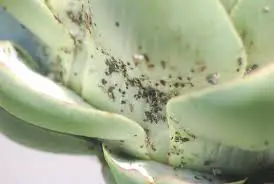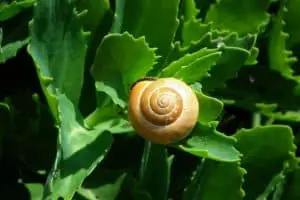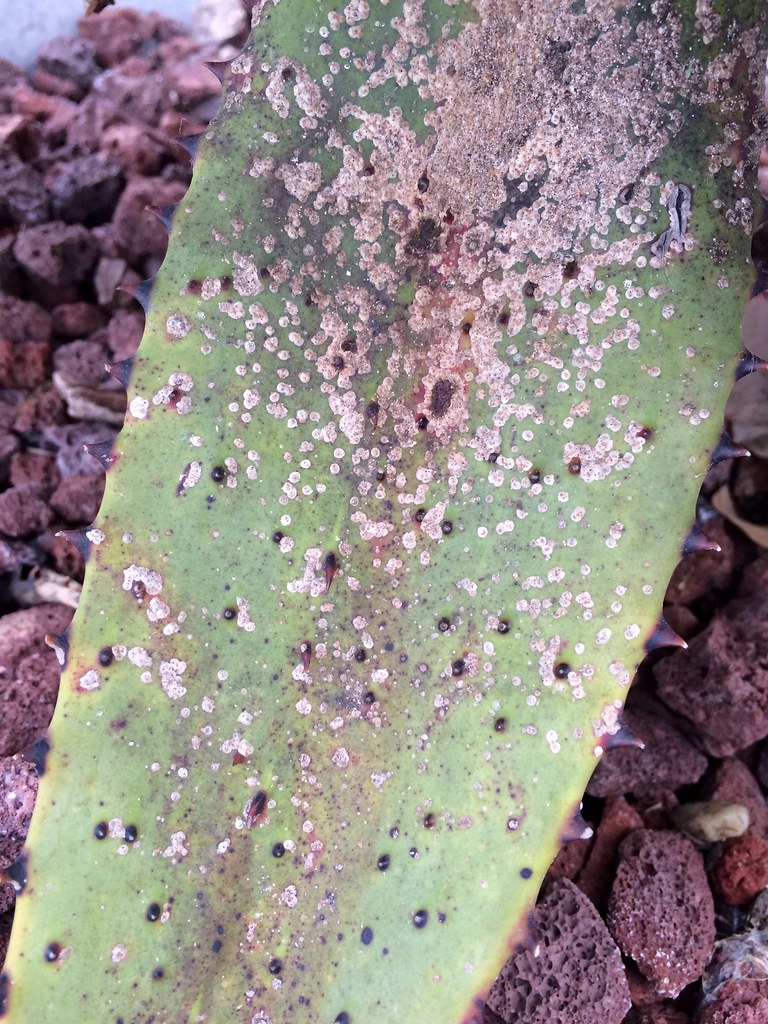Insects and other wildlife are a natural part of gardening. Some insects are beneficial to plants. Unfortunately, some insects and animals will harm your succulents or cacti. No gardener wants to see their beloved plants get sick or die. The list below describes some of the pests you may encounter while growing succulents or cacti and how to deal with any potential infestations.
1. Mealy Bugs
Mealy bugs are one of the most common pest control problems for succulents. They are soft, wingless insects that look like white, fluffy masses on plants. Mealy bugs use their long mouthparts to suck sap out of succulent tissue. This feeding is accompanied by a sticky substance that can cause black mold and attract ants.
Mealy bugs can infect indoor and outdoor plants.
The first thing you should do when you see mealy bugs on your succulents is to move the infected plant away from the rest of your plants. This will prevent mealy bugs from infecting other plants.
For small mealy bug infestations, you can spray a mixture of 70% isopropyl (rubbing) alcohol and water. Make sure the solution is dilute enough to make sure the rubbing alcohol mixture does not cause leaf burn.
Alternatively, you can apply neem oil, insecticidal soaps, or horticultural oil directly to the mealy bugs.
Serious infestations may require more drastic measures. Remove the infected plant from its pot and wash the soil off of the roots. Then wash the plant with soapy water and rinse the plant. Finally, allow the plant to dry completely before replanting it in fresh soil.
Make sure to plant the succulent in a sterilized container to prevent future pest control problems.
The following video describes how to deal with mealy bugs.
2. Aphids
Aphids are tiny, soft-boiled insects that appear in clusters on the underside of leaves and flowers. Adult aphids have needle-like mouths that allow them to pierce plant tissue and remove the succulents’ fluid. This can lead to shriveled leaves and stunted growth.

In addition, aphids coat plants with a sticky residue that can attract ants. This sticky residue can also cause mold issues and fungal disease.
To get rid of aphids, spray a solution of water and rubbing alcohol on the infected succulent. You can also add a little bit of dish soap to your rubbing alcohol solution. Adding dish soap helps the solution stick to the plant a bit better.
A more aggressive approach is to spray your succulents with insecticidal soap.
To prevent aphids, make sure your succulents are planted in well-draining soil. In addition, avoid reusing potting soil in order to prevent pests and diseases from spreading to new pots.
3. Slugs and Snails
Slugs and snails eat holes in the leaves and flowers of low-growing succulents. I have also found a snail in my rat tail cactus (Aporocactus flagelliformis).

Snails and slugs like cool, moist conditions. As a result, they are particularly active at night or during cloudy days.
Luckily there are a few ways to to prevent snails and slugs from damaging your beloved cacti and succulents.
One way to keep snails and slugs from attacking your plants is to crush up eggshells and scatter the pieces around the base of your plants. Because snails and slugs have delicate skin, they will want to avoid these shards of eggshell.
Another way to protect your succulente and cacti is to install copper screens around your plants. This is effective because the slime that slugs or snails produce react with copper causing an electric shock. When erecting a copper screen, bury several inches of copper below the soil surface to prevent slugs and snails from digging under the screen.
As you may know, salt kills snails and slugs. However, salt is not the best pest control option because adding salt to the soil can be detrimental to your plants.
4. Spider Mites
Although spider mites are not spiders, they are relatives of spiders. They both have eight legs and belong to the Arachnid family.
Spider mites can impact your indoor and outdoor succulents. Spider mites live in large colonies on the underside of leaves or where the stem and leaves meet. They puncture the top layer of the fleshy leaves and suck out fluids from the succulent. Because spider mites live in such large colonies, they can cause a lot of damage.
Unlike many of the other pests on this list, spider mites prefer dry conditions rather than warm, moist environments.
It can be difficult to get rid of spider mites. Because they are so small, gardeners typically don’t even know they are there until the infestation has become a significant problem.
To prevent spider mite problems, inspect your plants on a regular basis. Damage from spider mites typically appears as small dots or patches of discoloration.
Unfortunately, it is difficult to get rid of spider mites. There are a number of treatments you can try such as neem oil, insecticidal soap, and even predatory mites.
5. Scales
There are over 1,000 species of scale. Each specie differs in size, shape, and color. Small, brown bumps on the leaves of your succulents indicate a scale problem.

Scales eat succulents’ sap. The wounds from this feeding can make the succulents susceptible to diseases.
If you notice that there are scales on your succulent, begin by physically removing any visible insects from the plant. You can do this by using a hose to spray them off or by scraping them off of the leaves. Then spray the plant with a dilute mixture of rubbing alcohol and water.
Some gardeners have also successfully gotten rid of scales using neem oil. Mix a tablespoon of neem oil in eight cups of water. Spray this mixture on the infected areas of the plant.
If you are dealing with a serious scale infestation, more drastic measures are necessary. Remove the infected succulent from its pot and wash all of the soil from the roots and leaves of the plant. Then spray the plant with a mixture of soapy water and a little bit of rubbing alcohol. Rinse off the plant and allow it to dry for a few days before replanting the succulent in fresh potting soil.
6. Ants
Unlike some of the other insects on this list, ants do not cause direct harm to plants. However, they can be an indication of other harmful pests such as mealybugs and aphids. This is because ants love the sweet substance that mealybugs and aphids secrete.
7. Fungus Gnats
Fugus gnats are about the size of a fruit fly that primarily affects indoor plants. They lay their eggs on the surface of wet soil. Fungus gnats do not spread diseases and cannot bite. However, they can cause damage to the roots of your plants.

Fungus gnats are attracted to wet soil. So containers with poor drainage make a good breeding ground for these little insects. If you are having issues with fungus gnats, let the soil dry out completely after watering to see if they go away. If the fungus gnats leave, consider repotting them in a soil with better drainage.
To kill the fungus gnats already in your house, build a white wine trap. Put a splash of white wine into a cup and cover the cup with plastic wrap. Then poke a few holes in the plastic wrap. The holes should be large enough that the gnats can enter the trap. The gnats will be attracted by the sweet smell of the white wine, fly in the cup and not be able to escape.
You can create a similar trap using a few tablespoons of apple cider vinegar and a few drops of dish soap.
Alternatively, you can try putting some diatomaceous earth (DE) on top of the soil. This will kill adult gnats as well as the larvae.
8. Whiteflies
As the name implies, whiteflies are small white flies (about 1.5 mm long) that look like moths covered in flour. The larvae are a yellowish green color.
Whiteflies are not a problem for all species of succulents. Whiteflies only tend to be an issue for owners of succulents belonging to Euphorbias, which is a very large genus comprised of over 1,200 succulents.

Whiteflies eat the sap of Euphorbias. Then they excrete a honeydew substance that can cause black mold to grow on the plant. Serious infestations can cause the plant to turn yellow and black.
If you find that one of your succulents is suffering from a whitefly infestation, isolate it from other plants to prevent the infestation from spreading. Then use sticky strips to remove the adult whiteflies. Spray the plants every week for about a month with pyrethrum or insecticide.
Alternatively, whiteflies can be dealt with using parasitic wasps.
9. Cactus Coreid Bugs
Chelinidea vittiger, commonly known as cactus coreid bugs, eat cacti, especially prickly pear cacti. They are small bugs (0.25 – 0.5 inches long) that are green and brown in color.

When cactus coreid bugs initially infest a cactus, they cause black spots on the pads of the plant. Long term infestations can cause even more significant damage like large sections of weak or dead plant material.
To remove cactus coreid bugs, vacuum the bugs from the surface of the plant. Then drown them in a bucket of water. Alternatively, you can exterminate them using insecticides.
10. Nematodes
Nematodes affect cacti and succulents. Nematodes are microscopic organisms that live in soil and feed on plants.
Some nematodes are nitrogen-fixing and can be beneficial to plants. However, some nematodes can cause serious damage.
Root knot nematodes are common pests for cacti owners. They usually create fleshy masses on the roots called galls. To prevent root knot nematode issues, make sure you are using sterile potting soil. In addition, clean all containers thoroughly before planting.

Other types of nematodes can prevent plant roots from taking up nutrients. This can cause stunted growth. In addition, lesion nematodes can cause dead spots around feeding areas that can cause root rot.
Prevention is the best way to deal with nematodes. However, nematicide is a type of pesticide that can be used to kill nematodes.
11. Rodents
Rodents such as ground squirrels, rats, and gophers eat a variety of cacti because they are seeking the nectar within the cactus. These rodents will even feed on prickly pear cacti despite the spines. Rodents will also eat succulent leaves in order to obtain the moisture.
Although cacti tend to be hardy plants, rodents can cause serious damage to cacti. Fortunately, there are a few things that gardeners can do to get rid of rodents.
One way to deter rodents from your cacti is to put a wire fence around the cacti. Rodents are capable of digging, so make sure you bury the fence at least 6 to 9 inches.
Another option is to plant mint around your cacti. The aroma deters rodents. Mint grows very aggressively, so consider planting mint in containers if that is not desired.
Some gardeners have also had good luck sprinkling predator urine (e.g., wolf, coyote, and fox) around cacti.
Finally, try covering the soil with gravel or rock. This will at least slow down any potential rodent digging.
12. Cactus Longhorn Beetles
Cactus are large black beetles (at least 1 inch long) that cannot fly. They are found in the deserts located within the southwestern United States and northern Mexico. They are particularly prevalent in the Sonoran Desert.
These beetles eat prickly pear cacti and chollas. It is important to note that adult cactus longhorn beetles do not feed on cacti. However, juvenile cactus longhorn beetles can cause significant damage.
The larvae burrow into the cactus then secrete a green substance that hardens into a black. Throughout the winter, the larvae will feed on roots and tissue within the cactus. Because of this feeding, the cactus can soften in spots and eventually collapse on itself.
Although you cannot remove larvae once they burrow into the cactus, you can prevent adults from producing the next generation of cactus longhorn beetles. Simply pick the beetle off of the cactus if you see them.
Here is a YouTube video that shows cactus longhorn beetles eating a cactus.
13. Agave Snout Weevil
Agave snout weevils, which are also known as the sisal weevils, like to feed on a variety of species of agave. However, they seem to be particularly attracted to the century plant. Agave snout weevils are large black beetles that are about 1/2 inch long. They do not have wings and cannot fly.
Agave snout weevils are commonly found in the southwestern United States. They have also moved into Southern California.
Some symptoms of an agave snout weevil infestation include damage to the lower leaves. Agave snout weevil attacks the core of the agave plant and inject a bacteria that degrade the plant tissue of the plant. Then they lay their eggs, and grubs move into the soil and pupate. After growing to maturity, they emerge as beetles that will go on infect other agave plants.
Eventually, a plant infested with agave snout weevil will rot and become mushy.
Unfortunately, it is difficult to control agave snow weevils. It is more practical to select species of agave that are less susceptible to infestations. These include species of agave with soft leaves and agave with slender leaves. It is also more difficult for agave snout weevils to access plants grown in pots.
This video contains helpful information for preventing and treating plants infested with agave snout weevils.
14. Birds
Birds can be another nuisance for succulent owners. They are seeking moisture from the succulents.
There are a few ways to deal with a bird nuisance. Based on my research, it appears that fake owls are the most effective way to deter birds. However, some people do not want to display fake owls in their garden.
Another strategy is to place a birdbath in your garden to provide the water that birds are seeking.
Finally, you can try placing reflective things around your garden to deter birds.
